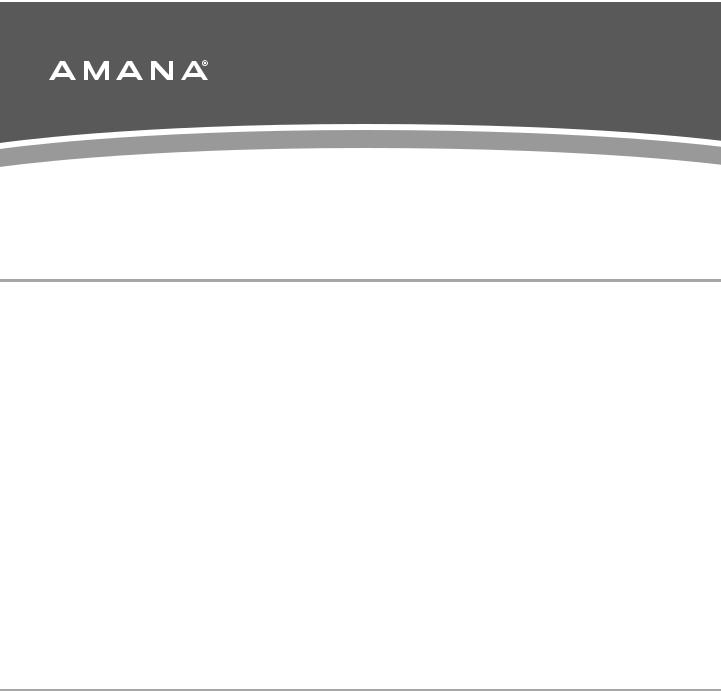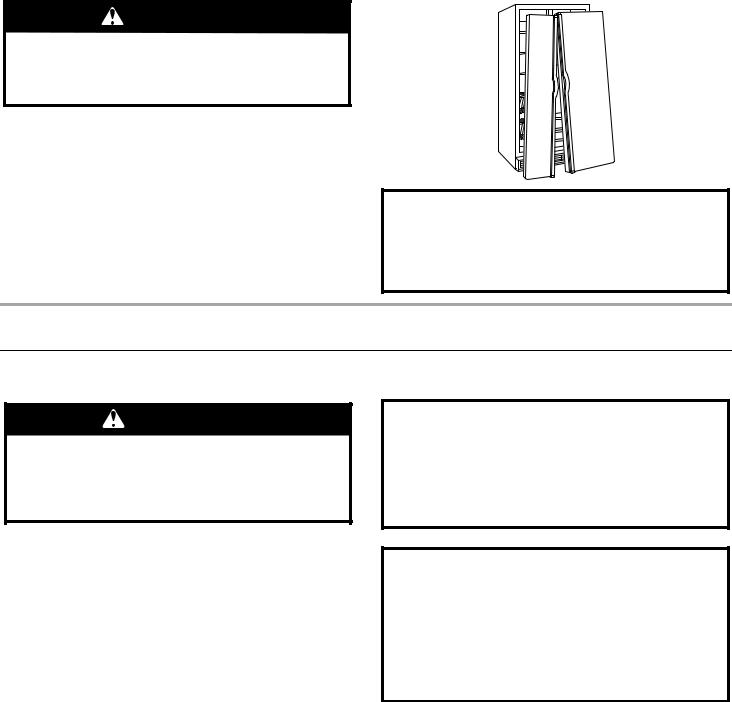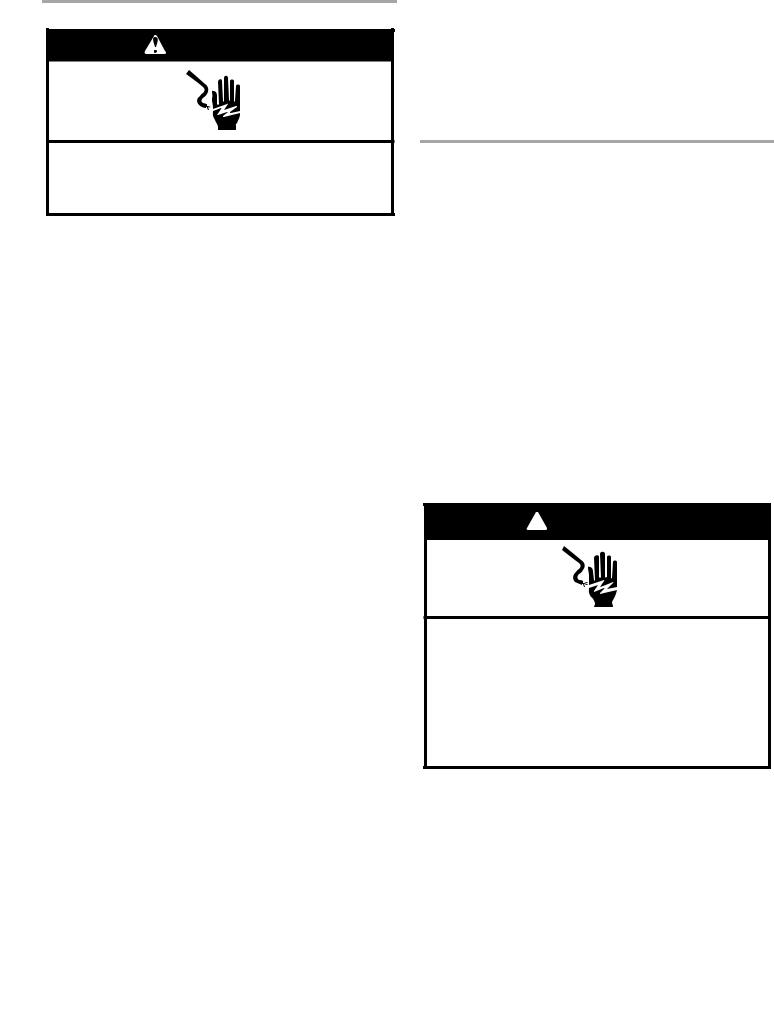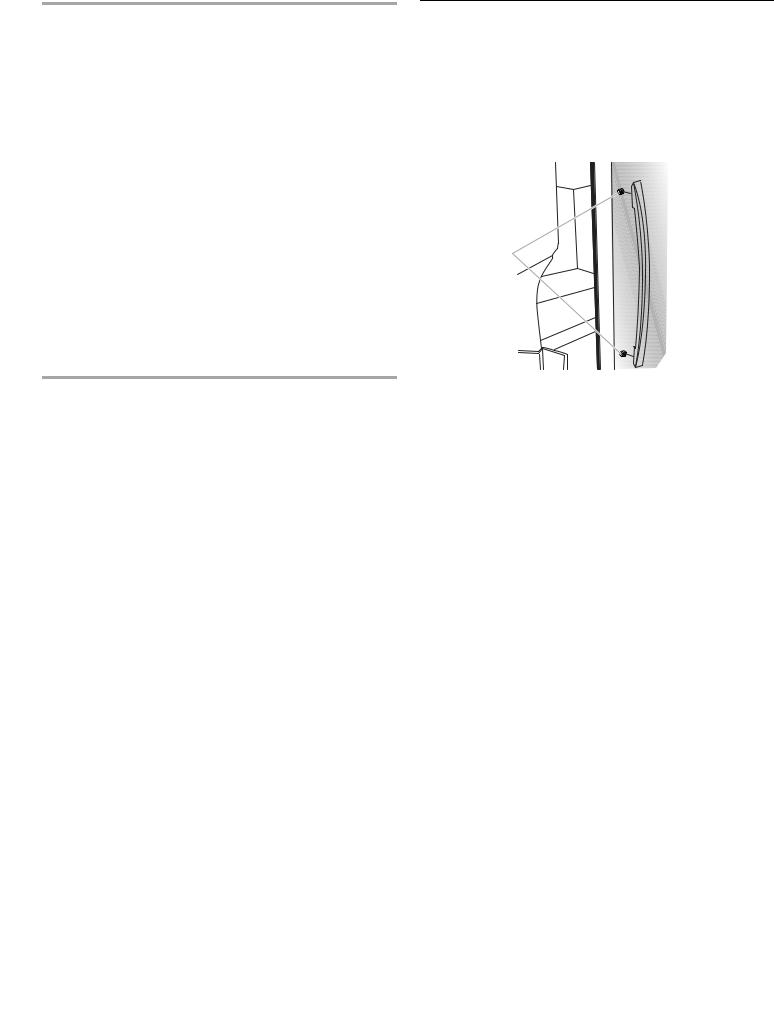Amana ASI2575FRW00, ASI2575FRS00, ASI2575FRB00 Owner’s Manual

REFRIGERATOR
USER INSTRUCTIONS
THANK YOU for purchasing this high-quality product. Register your new refrigerator at www.amana.com. In Canada, register your refrigerator at www.amanacanada.ca.
For future reference, please make a note of your product model and serial numbers. These can be located on the inside wall of the refrigerator compartment.
Model Number __________________________________________________ |
Serial Number __________________________________________________ |
Table of Contents / Índice/ Table des matières
REFRIGERATOR SAFETY ............................... |
2 |
Proper Disposal of Your Old Refrigerator ..... |
3 |
INSTALLATION INSTRUCTIONS .................... |
3 |
Unpack the Refrigerator ................................ |
3 |
Door Removal, Leveling and Alignment ........ |
4 |
Handle Installation and Removal................... |
6 |
Location Requirements.................................. |
7 |
Electrical Requirements................................. |
7 |
Water Supply Requirements.......................... |
7 |
Connect Water Supply .................................. |
8 |
REFRIGERATOR USE .................................... |
10 |
Using the Controls ....................................... |
10 |
Crisper Humidity Control ............................. |
10 |
Water and Ice Dispensers............................ |
10 |
Ice Maker and Storage Bin.......................... |
12 |
Water Filtration System ............................... |
12 |
REFRIGERATOR CARE ................................. |
13 |
Cleaning ....................................................... |
13 |
Lights............................................................ |
13 |
Vacation and Moving Care .......................... |
13 |
TROUBLESHOOTING .................................... |
14 |
ACCESSORIES ............................................... |
18 |
PERFORMANCE DATA SHEET..................... |
19 |
WARRANTY .................................................... |
20 |
SEGURIDAD DEL REFRIGERADOR............. |
21 |
Cómo deshacerse adecuadamente |
|
de su refrigerador viejo ................................ |
22 |
INSTRUCCIONES DE INSTALACIÓN........... |
22 |
Desempaque el refrigerador........................ |
22 |
Remoción, nivelación y alineamiento |
|
de las puertas .............................................. |
23 |
Cómo instalar y remover las manijas .......... |
25 |
Requisitos de ubicación .............................. |
26 |
Requisitos eléctricos.................................... |
26 |
Requisitos del suministro de agua .............. |
26 |
Conexión del suministro de agua................ |
27 |
USO DE SU REFRIGERADOR....................... |
29 |
Uso de los controles.................................... |
29 |
Control de humedad del cajón |
|
para verduras............................................... |
30 |
Despachadores de agua y hielo.................. |
30 |
Fábrica de hielo y depósito ......................... |
31 |
Sistema de filtración de agua ...................... |
32 |
CUIDADO DE SU REFRIGERADOR.............. |
33 |
Limpieza....................................................... |
33 |
Luces............................................................ |
33 |
Cuidado durante |
|
las vacaciones y mudanzas......................... |
33 |
SOLUCIÓN DE PROBLEMAS........................ |
34 |
ACCESORIOS ................................................. |
39 |
HOJA DE DATOS DEL RENDIMIENTO ........ |
40 |
GARANTÍA...................................................... |
41 |
SÉCURITÉ DU RÉFRIGÉRATEUR .............. |
42 |
Mise au rebut appropriée |
|
de votre vieux réfrigérateur.......................... |
43 |
INSTRUCTIONS D’INSTALLATION .............. |
43 |
Déballage du réfrigérateur ........................... |
43 |
Retrait, réglage de l’aplomb |
|
et alignement des portes ............................. |
44 |
Installation et démontage des poignées ..... |
46 |
Exigences d’emplacement .......................... |
47 |
Spécifications électriques............................ |
47 |
Spécifications de l’alimentation en eau....... |
47 |
Raccordement de la canalisation d’eau...... |
48 |
UTILISATION DU RÉFRIGÉRATEUR............ |
50 |
Utilisation des commandes ......................... |
50 |
Réglage de l’humidité dans |
|
le bac à légumes.......................................... |
51 |
Distributeurs d’eau et de glaçons................ |
51 |
Machine à glaçons et bac d’entreposage... |
52 |
Système de filtration de l’eau ...................... |
53 |
ENTRETIEN DU RÉFRIGÉRATEUR .............. |
54 |
Nettoyage..................................................... |
54 |
Lampes ........................................................ |
54 |
Entretien avant les vacances ou |
|
lors d’un déménagement............................. |
54 |
DÉPANNAGE .................................................. |
56 |
ACCESSOIRES ............................................... |
61 |
FEUILLE DE DONNÉES SUR LA |
|
PERFORMANCE............................................. |
62 |
GARANTIE....................................................... |
63 |
W10877550A

REFRIGERATOR SAFETY
Your safety and the safety of others are very important.
We have provided many important safety messages in this manual and on your appliance. Always read and obey all safety messages.
This is the safety alert symbol.
This symbol alerts you to potential hazards that can kill or hurt you and others.
All safety messages will follow the safety alert symbol and either the word “DANGER” or “WARNING.” These words mean:
 DANGER
DANGER
 WARNING
WARNING
You can be killed or seriously injured if you don't immediately follow instructions.
You can be killed or seriously injured if you don't follow instructions.
All safety messages will tell you what the potential hazard is, tell you how to reduce the chance of injury, and tell you what can happen if the instructions are not followed.
IMPORTANT SAFETY INSTRUCTIONS
WARNING: To reduce the risk of fire, electric shock, or injury when using your refrigerator, follow these basic precautions:
■Plug into a grounded 3 prong outlet.
■Do not remove ground prong.
■Do not use an adapter.
■Do not use an extension cord.
■Disconnect power before servicing.
■Replace all parts and panels before operating.
■Remove doors from your old refrigerator.
■Connect to a potable water supply only.
■Use nonflammable cleaner.
■Keep flammable materials and vapors, such as gasoline, away from refrigerator.
■Use two or more people to move and install refrigerator.
■Disconnect power before installing ice maker (on ice maker kit ready models only).
■Use a sturdy glass when dispensing ice (on some models).
■Do not hit the refrigerator glass doors (on some models).
■This appliance is not intended for use by persons (including children) with reduced physical, sensory or mental capabilities, or lack of experience and knowledge, unless they have been given supervision or instruction concerning use of the appliance by a person responsible for their safety.
■Children should be supervised to ensure that they do not play with the appliance.
SAVE THESE INSTRUCTIONS
State of California Proposition 65 Warnings:
WARNING: This product contains one or more chemicals known to the State of California to cause cancer.
WARNING: This product contains one or more chemicals known to the State of California to cause birth defects or other reproductive harm.
2

Proper Disposal of Your Old Refrigerator |
■ Leave the shelves in place so that children may not easily climb |
|
inside. |
WARNING
Suffocation Hazard
Remove doors from your old refrigerator.
Failure to do so can result in death or brain damage.
IMPORTANT: Child entrapment and suffocation are not problems of the past. Junked or abandoned refrigerators are still dangerous, even if they will sit for “just a few days.” If you are getting rid of your old refrigerator, please follow these instructions to help prevent accidents.
Before You Throw Away Your Old Refrigerator or Freezer:
■Take off the doors.
Important information to know about disposal of refrigerants:
Dispose of refrigerator in accordance with Federal and Local regulations. Refrigerants must be evacuated by a licensed, EPA certified refrigerant technician in accordance with established procedures.
INSTALLATION INSTRUCTIONS
Unpack the Refrigerator
WARNING
Excessive Weight Hazard
Use two or more people to move and install refrigerator.
Failure to do so can result in back or other injury.
Remove packaging materials. Do not use sharp instruments, rubbing alcohol, flammable fluids, or abrasive cleaners to remove tape or glue. These products can damage the surface of your refrigerator. For more information, see “Refrigerator Safety.”
When Moving Your Refrigerator:
Your refrigerator is heavy. When moving the refrigerator for cleaning or service, be sure to cover the floor with cardboard or hardboard to avoid floor damage. Always pull the refrigerator straight out when moving it. Do not wiggle or “walk” the refrigerator when trying to move it, as floor damage could occur.
Important information to know about glass shelves and covers:
Do not clean glass shelves or covers with warm water when they are cold. Shelves and covers may break if exposed to sudden temperature changes or impact, such as bumping. Tempered glass is designed to shatter into many small, pebble-size pieces. This is normal. Glass shelves and covers are heavy. Use both hands when removing them to avoid dropping.
3

Door Removal, Leveling and Alignment
Gather the required tools and parts and read all instructions before starting installation. Save these instructions for future reference.
NOTE: Before moving your product into your home, measure the doorway of your home to see whether you need to remove the refrigerator and freezer doors. If door removal is necessary, see the instructions below.
IMPORTANT: Before you begin, turn the refrigerator control OFF or turn cooling off. Unplug refrigerator or disconnect power. Remove food, the ice storage bin (on some models), and any adjustable door or utility bins from doors.
TOOLS NEEDED:
Bubble level; flat-blade screwdriver; ⁄" wrench; ¹⁄", ¹⁄", and ⁄" hex-head socket wrenches
 WARNING
WARNING
Electrical Shock Hazard
Disconnect power before removing doors.
Failure to do so can result in death or electrical shock.
4 |
Top Left Hinge |
|
A |
|
A |
A. Do Not Remove Screws. |
|
3 |
Wiring Connection |
||
|
A |
B |
C |
|
A. Wiring Plugs |
|
|
|
B. Wiring Clip |
|
|
|
C. Grommets |
|
|
2 |
Water Dispenser |
|
Tubing Connection |
|
A |
|
A |
|
A. Face of Fitting |
5 |
Door Removal |
6 |
|
Top Right Hinge |
|
|
|
|
A |
|
|
|
|
|
|
|
A |
|
|
|
A. Do Not Remove Screws. |
||
|
|
|
7 |
|
Bottom Hinges |
|
|
|
|
(Left and Right) |
|
|
|
|
|
A |
|
|
|
|
Do Not Remove Screw A |
||
|
|
|
(present on some models) |
||
|
|
|
8 |
|
Leveling |
|
|
|
|
|
Raise |
|
|
|
|
Lower |
|
|
|
|
|
|
A |
|
|
|
|
|
A. Leveling Screw |
|
|
|
9 |
Door Alignment |
|
|
|
|
|
(Bottom Right Hinge) |
|
|
1 |
Base Grille |
|
|
|
|
|
|
|
A |
Raise |
|
|
|
|
|
|
|
|
|
|
|
Lower |
|
|
|
|
A. Alignment Screw |
|
4

Remove the Doors
WARNING
Hazard
Disconnect power before removing doors.
Failure to do so can result in death or electrical shock.
1.Unplug refrigerator or disconnect power.
2.Open both doors (refrigerator and freezer) and the water filter cover door. It is not necessary to remove the water filter itself.
3.Remove the base grille by pulling up on the bottom outside corners. See Graphic 1.
4.Disconnect the water dispenser tubing located behind the base grille on the freezer door side. The dispenser tubing runs through the door hinge, and must be disconnected in order to remove the door. See Graphic 2.
■Press blue outer ring against the face of fitting and pull the dispenser tubing free.
NOTE: Keep the water tubing connector attached to the tube that runs underneath the freezer. The door cannot be removed if the connector is still attached to the tube that runs through the door hinge.
5.Disconnect the wiring located behind the base grille on the freezer door side. See Graphic 3.
■Remove the wiring clip using a ¹⁄" hex-head socket wrench.
■Disconnect wiring plugs.
6.Close both doors and keep them closed until you are ready to lift them free from the cabinet.
7.Use a ⁄" hex-head socket wrench to remove the top left hinge as shown. See Graphic 4.
IMPORTANT: Do not remove either screw A.
8.Lift freezer door straight up off bottom hinge. See Graphic 5. The water dispenser tubing and wiring remain attached to the freezer door and pull through the bottom left hinge.
NOTE: This may require two people - one to lift the door and another to feed the water tubing and wiring through the hinge.
IMPORTANT: Rest the door on its side on a soft, clean surface, such as a towel, blanket or piece of cardboard. This will help avoid damaging the door, water tubing and wiring.
9.Remove top right hinge as shown. See Graphic 6. IMPORTANT: Do not remove either screw A.
10.Lift the refrigerator door straight up off bottom hinge.
IMPORTANT: Rest the door on its side on a soft, clean surface, such as a towel, blanket or piece of cardboard. This will help avoid damaging the door.
11.It may not be necessary to remove the bottom hinges to move the refrigerator through a doorway. Both bottom hinges have similar construction.
■If necessary, disassemble the hinges as shown. See Graphic 7.
IMPORTANT: To aid in door alignment and closing, there is a shim located between the hinge and the cabinet. When the hinge is removed, the shim may fall out of place. If this occurs, set the shim aside so it can be put back in place when the hinge is reconnected later.
Replace the Doors and Hinges
1.Replace both bottom hinges, if removed. Make sure the shim is between the hinge and cabinet. Tighten screws.
2.Before replacing the freezer door on the bottom left hinge, feed the wiring with the yellow plug and the water dispenser tubing through the hinge. Assistance may be needed.
NOTE: Provide additional support for the doors while the top hinges are being replaced. Do not depend on the door magnets to hold the doors in place while you are working.
3.Align and replace the top left hinge as shown. See Graphic 4. Tighten screws.
4.Reconnect water dispenser tubing and wiring.
IMPORTANT: Do not intertwine the water tubing and wiring bundles when reconnecting them.
■Push tubing into fitting until it stops and the black mark touches the face of fitting. See Graphic 2.
■Reconnect wiring plugs. Reinstall the wiring clip over the grommets. Tighten screw. See Graphic 3.
5.Replace the refrigerator door by lifting the door onto the bottom right hinge.
6.Align and replace the top right hinge as shown. See Graphic 6. Tighten screws.
7.Replace the ice storage bin (on some models) and any adjustable door or utility bins.
 WARNING
WARNING
Electrical Shock Hazard
Plug into a grounded 3 prong outlet.
Do not remove ground prong.
Do not use an adapter.
Do not use an extension cord.
Failure to follow these instructions can result in death, fire, or electrical shock.
8. Plug into a grounded 3 prong outlet.
5

Leveling and Door Closing
Your refrigerator has two front adjustable rollers — one on the right and one on the left. If your refrigerator seems unsteady or if you want the doors to close more easily, adjust the refrigerator's tilt using the instructions below:
1.Move the refrigerator into its final location.
2.Remove the base grille to locate the two leveling screws, which are part of the front roller assemblies on each side.
See Graphic 8.
NOTE: Having someone push against the top of the refrigerator takes some weight off the leveling screws and rollers. This makes it easier to adjust the screws.
3.Use a ¹⁄" hex-head socket wrench to adjust the leveling screws. Turn the leveling screw to the right to raise that side of the refrigerator or turn the leveling screw to the left to lower that side. It may take several turns of the leveling screws to adjust the tilt of the refrigerator. See Graphic 8.
4.Open both doors again and check that they close as easily as you like. If not, tilt the refrigerator slightly more to the rear by turning both leveling screws to the right. It may take several more turns, and you should turn both leveling screws the same amount.
5.Use a bubble level to check the leveling of the refrigerator.
NOTE: Whenever you need to move the refrigerator, turn the leveling feet to the right until they are no longer touching the ground. This will allow the refrigerator to roll more easily.
Door Alignment
A refrigerator that is not level from side-to-side may appear to have doors that are not properly aligned. If the doors appear this way, use the instructions in the previous section to check the leveling.
The doors are designed to be slightly different heights when the refrigerator is empty, in order to account for the weight of food that will be placed on the doors. If the doors are still not aligned after checking the leveling and loading the refrigerator with food, follow the steps below to adjust the door alignment.
1.Locate the alignment screw on the bottom hinge of the refrigerator door. See Graphic 9.
2.Use a ⁄" wrench to turn the screw. To raise the refrigerator door, turn the screw to the right. To lower the door, turn the screw to the left.
3.Check that the doors are even at the top and bottom. If necessary, continue to turn the alignment screw until the doors are aligned.
4.Replace the base grille.
NOTE: Be sure to refasten the Tech Sheet behind the base grille.
Handle Installation and Removal
PARTS INCLUDED: Door handles (2)
To Install the Handles:
1.Remove the handles, which are packed inside the refrigerator.
NOTE: To avoid scratching the finish, place the handles on a towel or other soft surface.
2.Open the freezer door. On the refrigerator door, place the handle on the shoulder screws.
A
A.Shoulder screws
3.Firmly push the handle toward the door until the handle base is flush against the door.
4.While holding the handle, push downward until the handle rests firmly on shoulder screw.
5.Open the refrigerator door and close the freezer door. Repeat steps 2 through 4 to install the other handle onto the freezer door.
To Remove the Handles:
1.While holding the handle, push upward until the handle is released from the shoulder screw.
2.Gently pull the handle away from the door.
3.If necessary, use a Phillips screwdriver to remove the shoulder screws from the door.
6

Location Requirements
WARNING
Explosion Hazard
Keep flammable materials and vapors, such as gasoline, away from refrigerator.
Failure to do so can result in death, explosion, or fire.
IMPORTANT: This refrigerator is designed for indoor household use only.
To ensure proper ventilation for your refrigerator, allow for ¹⁄ " (1.27 cm) of space on each side and at the top. Allow for 2"
(5.08 cm) of space behind the refrigerator. If your refrigerator has an ice maker, allow extra space at the back for the water line connections. When installing your refrigerator next to a fixed wall, leave a 2" (5.08 cm) minimum space on each side (depending on your model) to allow the doors to swing open.
1/2" (1.27 cm)
2" (5.08 cm)
NOTES:
■This refrigerator is intended for use in a location where the temperature ranges from a minimum of 55°F (13°C) to a maximum of 110°F (43°C). The preferred room temperature range for optimum performance, which reduces electricity usage and provides superior cooling, is between 60°F (15°C) and 90°F (32°C). It is recommended that you do not install the refrigerator near a heat source, such as an oven or radiator.
■Normal minimum cabinet cut-out width required for product installation is 36" (91.44 cm). However, if the product is placed against an extended wall and the ability to remove the crisper pans is desired, an additional 18" (45.72 cm) of cabinet width is required, so a total cabinet opening width of 54" (137.16 cm) is recommended.
Electrical Requirements
 WARNING
WARNING
Electrical Shock Hazard
Plug into a grounded 3 prong outlet.
Do not remove ground prong.
Do not use an adapter.
Do not use an extension cord.
Failure to follow these instructions can result in death, fire, or electrical shock.
Before you move your refrigerator into its final location, it is important to make sure you have the proper electrical connection.
Recommended Grounding Method
A 115-volt, 60 Hz, AC-only, 15or 20-amp fused, grounded electrical supply is required. It is recommended that a separate circuit serving only your refrigerator be provided. Use an outlet that cannot be turned off by a switch. Do not use an extension cord.
NOTE: Before performing any type of installation or cleaning, or removing a light bulb, turn cooling off or turn the control (Thermostat, Refrigerator or Freezer Control depending on the model) to OFF, and then disconnect the refrigerator from the electrical source. When you are finished, reconnect the refrigerator to the electrical source and turn cooling on or reset the control (Thermostat, Refrigerator or Freezer Control depending on the model) to the desired setting. See “Using the Controls” in the User Instructions, User Guide, or Use & Care Guide.
Water Supply Requirements
Gather the required tools and parts before starting installation. Read and follow the instructions provided with any tools listed here.
TOOLS NEEDED:
■ |
Flat-blade screwdriver |
■ |
¹⁄ " nut driver |
■ |
⁄ " and ¹⁄ " open-end or |
■ |
¹⁄ " drill bit |
|
two adjustable wrenches |
■ |
Cordless drill |
|
|
NOTE: Your refrigerator dealer has a kit available with a ¹⁄ " (6.35 mm) saddle-type shutoff valve, a union, and copper tubing. Before purchasing, make sure a saddle-type valve complies with your local plumbing codes. Do not use a piercing-type or ³⁄ "
(4.76 mm) saddle valve which reduces water flow and clogs more easily.
IMPORTANT:
■All installations must meet local plumbing code requirements.
■Use copper tubing and check for leaks. Install copper tubing only in areas where the household temperatures will remain above freezing.
7
